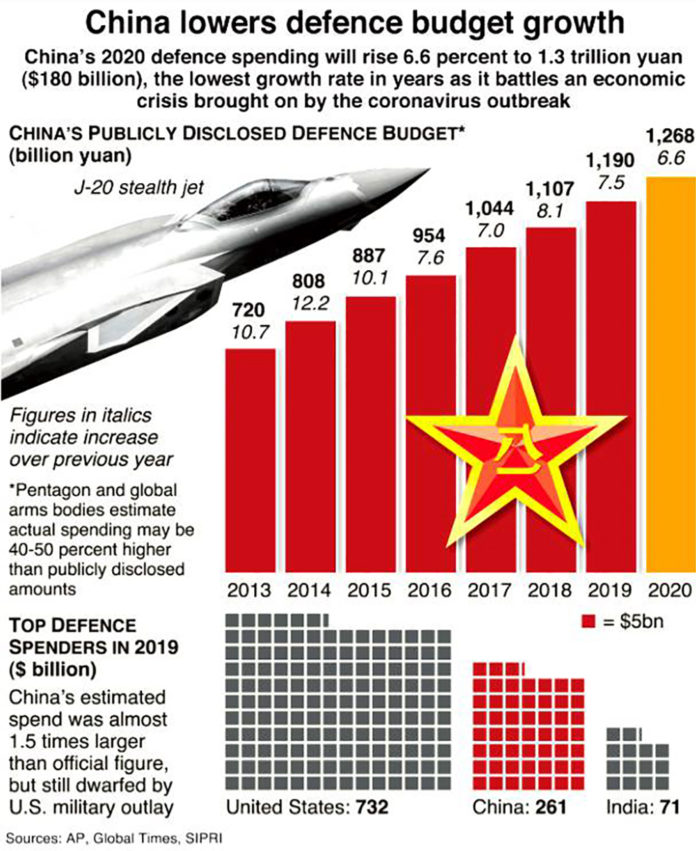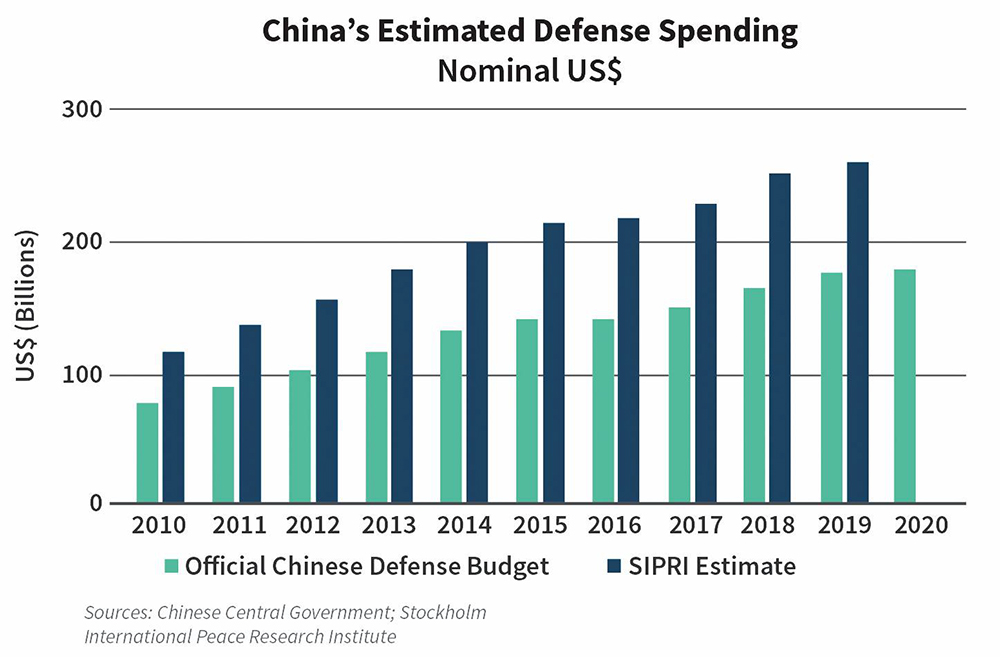China has hiked its defence budget from last year’s $177.6 billion to USD 179 billion, nearly three times that of India, the lowest increment in recent years apparently due to the heavy disruption caused to its economy by the Covid-19. When using constant 2010 dollars to account for inflation, China’s expected defence spending appears to dip from $143.8 billion in 2019 to $140.5 in 2020. (Constant 2010 values are calculated based on GDP projections.)
China, which has the world’s largest military of two million troops, will continue to lower its defence budget growth rate to 6.6 per cent in 2020, according to a draft budget report presented on 22 May, to National People’s Congress (NPC), the country’s top legislature. The 2020 defence budget continues to see single-digit growth for a fifth consecutive year. It is the lowest growth rate in recent years, the state-run Xinhua news agency reported.
Spending on the military as a percent of overall national government spending will rise slightly from 5.06 percent in 2019 to 5.12 percent in 2020, and spending as a percent of the central government budget will rise from 33.6 percent to 36.2 percent.
China’s total defence spending in 2019 only amounted to a quarter that of the United States, the world’s largest defence spender, while the per capita expenditure was just about one-seventeenth, the report said.
China’s defence spending has been staying at around 1.3 per cent of its gross domestic product for many years, well below the world’s average of 2.6 per cent, according to the spokesman.
According to Stockholm International Peace Research Institute (SIPRI), the military expenditure figures of China’s defence spending in 2019 amounted to $232 billion.
Official vs Actual Expenditure
China’s actual level of defence expenditure per annum is a matter of conjecture and confusion due to the purposefully opaque approach of the communist regime.
When employing purchasing power parity (PPP) into an examination of China’s defence spending the “bang for the buck” Beijing wrings from its annual investment is significantly higher than a sheer dollar figure as internal costs of production and purchasing are not tied to currency exchange rates and the salaried cost of maintaining a large standing military is less for China than it is for the U.S., Britain, France, etc.
Elements such as military technological research and development and even some major weapons purchases are believed to be kept off-budget, thus raising actual defense investment figures to well above the official topline figure published by the Chinese state. Such “off-budget” investment is becoming more and more innovation-driven rather than mirroring conventional platform trends, with priority granted to emerging technologies such as artificial intelligence, unmanned systems, directed-energy weapons, and quantum computing.
The decrease in official Chinese defence spending hike (6.6%) compared to last year’s rise (7.5%) does not mean the People’s Liberation Army (PLA) is any less lethal. China says the increases in spending mostly go toward improving conditions for troops, while analysts say actual spending could be much higher because many items are not included in the official budget.
On 21 May, a spokesperson for the NPC in a media briefing played down criticism about lack of transparency in China’s defence expenditure, which defence analysts say considering the rapid expansion of Beijing’s military and modern weapons is far higher than what is announced. China does not specify the spending on pensions, the expense is shared by the Ministry of Veteran Affairs as well as provincial governments.
The Chinese government has in the past been inconsistent in its reporting on defence spending. China’s 2019 defence white paper, for instance, provides military spending figures that are slightly higher (between $2-3 billion each year) than the announced defence budgets. This discrepancy may be the result of the defence white paper including costs associated with militia forces in its figures.
Chinese military spending figures are marked by absence of a detailed breakdown of expenditure and the exclusion of various military-related outlays, including spending on the People’s Armed Police (PAP). A draft law revision that is being considered by the NPC would put the PAP under both the CMC and the Communist Party’s Central Committee. The official budget for the PAP was 179.78 billion yuan ($28.5 billion) in 2019.
In 2019, the Chinese government reported an official defence budget of just under $178 billion, while the Stockholm International Peace Research Institute (SIPRI) estimates actual (nominal) spending to have been $261 billion. The International Institute for Strategic Studies (IISS) provides estimates that are typically lower than those of SIPRI. In 2018, IISS estimated Chinese defence spending to be $225 billion, while SIPRI put the number at nearly $254 billion. The official budget that year was just $167 billion.
China’s Extensive Projects
On 22 March, Chinese Premier Li Keqiang told the Congress that “We will deepen reforms in national defense and the military, increase our logistic and equipment support capacity, and promote innovative development of defense-related science and technology.” He also called for reconciliation with Taiwan, notably avoiding the word “peaceful,” a term used as standard procedure in government comments about reunification.
Much of the spending will fund the ongoing modernisation of the People’s Liberation Army (PLA), and particularly on the expansion of the PLA Navy and the PLA Rocket Force, which have been garnering an increasing share. The Army has been downsized by 300,000 with a current active force of around 2 million.
Last year, China unveiled its first homegrown aircraft carrier, while two more are in construction. China in 2019 also unveiled its most advanced intercontinental ballistic missile, the Dongfeng-41, with an estimated 14,000 km range, capable of reaching the U.S.
This year’s spending will also help Beijing enforce its territorial claims in the South China Sea and expand its military presence in the Western Pacific and Indian Ocean. Another key priority is maintaining a credible threat against Taiwan, the self-governing island democracy China considers its own territory to be brought under its control by military force if necessary.
China’s defence budget in recent years acquired limelight as it embarked on a massive modernisation which included a number of aircraft carriers, stealth aircraft, rapid development of modern naval frigates. Since Chinese President Xi Jinping came to power, China has revamped its defence forces, cutting the army by three lakh troops and enhanced its naval and air power as Beijing expanded its influence abroad.
China currently has one aircraft carrier, the second one is undergoing trials while the third is being built. According to official media reports, China plans to have five to six aircraft carriers in near future to challenge the US all around the world including in Beijing’s backyard the South China Sea (SCS).
China claims all most all of the South China Sea as its territory. Vietnam, Philippines, Malaysia Brunei and Taiwan have counterclaims on it.
China is engaged in hotly contested territorial disputes in both the South China Sea and the East China Sea. Beijing has built up and militarised many of the islands and reefs it controls in the region. Both areas are stated to be rich in minerals, oil and other natural resources and are also vital to global trade.
Pushing India
While China compares its defence expenditure with the US, whose defence budget according to SIPRI was $732 billion, Beijing’s massive defencemodernisation drive is pushing India and a number of other countries to hike their own defence budgets to ensure reasonable balance of power.
India’s defence budget for 2020 amounted to $66.9 billion (Rs. 4,71,378 crore). China’s latest budget amounted to about 2.7 times more than that of India.



















